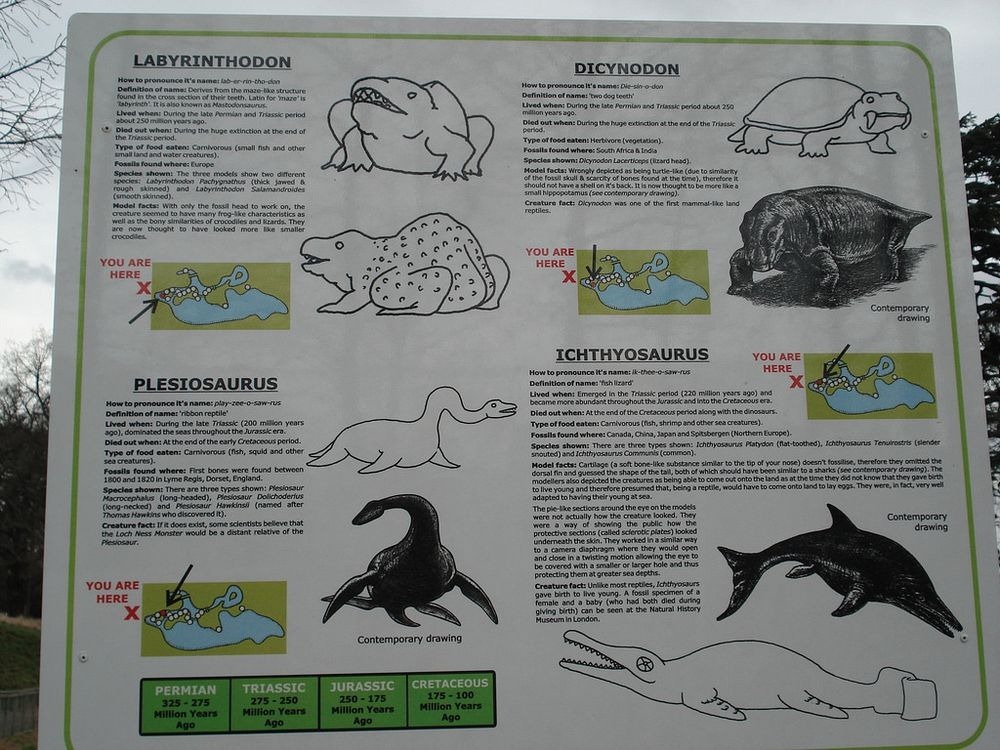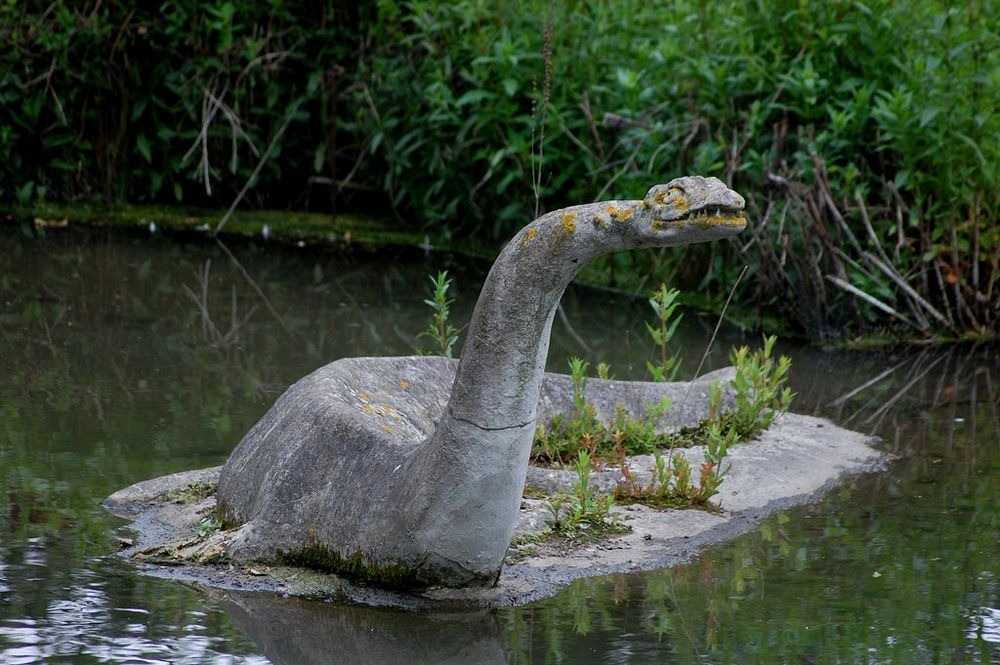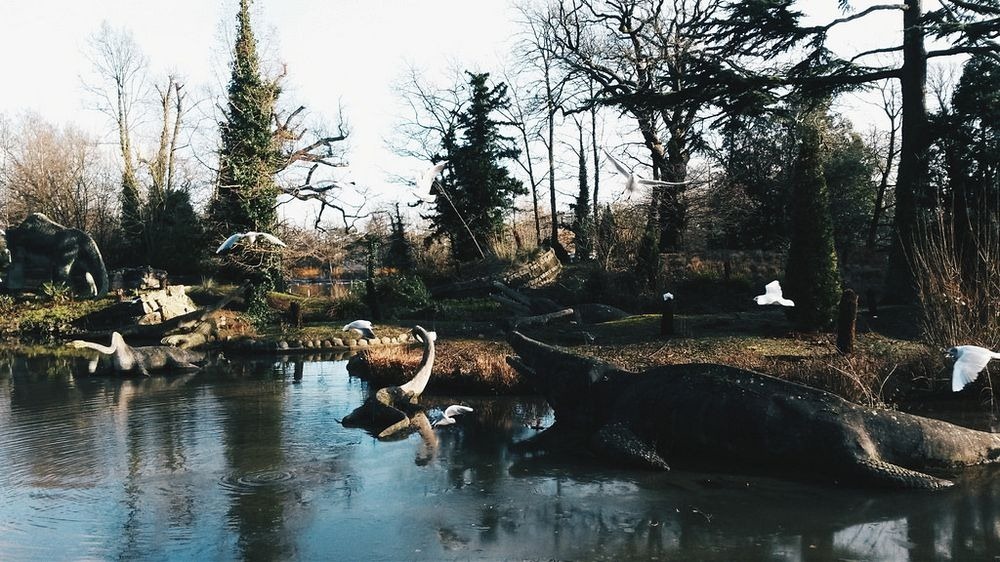Inside an enclosure at the Crystal Palace Park in London, is a collection of over thirty concrete sculptures of dinosaurs. Built more than one hundred sixty years ago, these sculptures were the first ever attempt anywhere in the world to model dinosaurs as full-scale, three-dimensional creatures. Although the sculptures are wildly inaccurate by modern standards, they are still an important part of history because they show how the Victorians viewed prehistoric life.
These concrete beasts were designed and built by sculptor Benjamin Waterhouse-Hawkins in collaboration with Professor Richard Owen, a celebrated biologist and paleontologist of the time, best remembered today for being the one who coined the word “dinosaur”, meaning “terrible lizard”. Hawkins and Richards were asked to build a total of thirty three models of dinosaurs, as well as other extinct animals, in 1852 as part of a new attraction at the recently relocated Crystal Palace Park in Sydenham in south London. The trouble was, Hawkins didn’t have enough fossil evidence to begin with. For instance, for the Iguanodon, the largest and the most impressive of the sculptures, Hawkins had no more than a handful of teeth and a few bones. So he did what anybody with a contract and a looming deadline would have done —he used his imagination.

A Megalosaurus model at Crystal Palace Park. Photo credit: Peter Reed/Flickr
Hawkins made sketches of the bones of fossilized animals and compared them with the bone structures of the nearest living creatures, and produced an outline of what he thought the extinct animal would have looked like. He then made small clay models and submitted them to Owen for his approval. Owen —not to take anything away from the man— wasn’t any wiser than Hawkins. He liked Hawkins’s model of the Iguanodon standing on all fours and having a horn like a rhinoceros's. We now know that the Iguanodons stands only on its hind legs and it has no horn. The horn in Hawkins’s model is actually a thumb bone, but Hawkins, in his ignorance, couldn’t figure out what it was and figured it would look better on top of the nose.
Back in 1852, more than half a decade before Charles Darwin proposed the theory of evolution, everything that Hawkins did seemed logical. The sculptor reasoned, and his famed advisor Owen agreed, that an animal as large as the Iguanodon couldn’t have stood on just two legs. Eventually, the Iguanodon became so large that its open mold could accommodate a New Year’s Eve dinner for Hawkins, Owen, and twenty other scientists in 1853.

The famous banquet inside the mould of the Crystal Palace Iguanodon on New Year's Eve, 1853.
Inaccuracies of that sort were abound in Hawkins’s model of the dinosaurs. Another example is the Megalosaurus, which like the Iguanodon, is depicted as standing on four legs and has a nonexistent hump. Similarly, the Ichthyosaurus looks like a crocodile with a giant dorsal fin, whereas current recreations suggest it looked more like a shark. And the Labyrinthodont? It resembles an oversized frog.
But back then, none of this mattered. The dinosaurs were an instant hit drawing millions of visitors to the park each year. But as the years rolled by, and our understanding of dinosaurs improved, Hawkins’s models became a joke and the subject of ridicule. Gradually, the public lost interest and they were forgotten until the early 2000s when the displays were renovated. Missing parts were recreated and damaged parts of the surviving models were recast. The park reopened in 2002.
The models and other elements of Crystal Palace Park were classed as Grade II listed buildings from 1973. After the renovation, they were upgraded to Grade I.


Photo credit: Ian Wright/Wikimedia

A sign at Crystal Palace Park comparing models of Hawkins’s dinosaurs with contemporary models. Photo credit: Simon Q/Flickr

A sign at Crystal Palace Park comparing models of Hawkins’s dinosaurs with contemporary models. Photo credit: Simon Q/Flickr

An Ichthyosaurus at Crystal Palace Park. Photo credit: Loz Pycock/Flickr

Photo credit: Andrea Marchesetti/Flickr

Photo credit: Toby Bradbury/Flickr

A Labyrinthodont at Crystal Palace Park. Photo credit: Zoe Rimmer/Flickr

Photo credit: CGP Grey

Photo credit: vanessa lollipop/Flickr
Sources: Friends of Crystal Palace Dinosaurs / New York Moon / The Victorian Web



Comments
Post a Comment